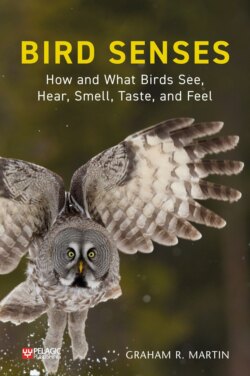Читать книгу Bird Senses - Graham R. Martin - Страница 44
На сайте Литреса книга снята с продажи.
The optical systems of camera eyes
ОглавлениеThe optical system is composed of two main elements (Figure 3.2). The cornea is the relatively simple curved surface at the front of the eye. In eyes that operate primarily in air, the cornea is essentially a boundary between air and the fluid-filled chamber of the eye. The radius of curvature of the cornea is the key to its image-forming properties. A more highly curved surface produces a smaller image than a shallowly curved surface. The lens is suspended in the fluids that fill the chambers of the eye. It is also relatively simple. Like a magnifying glass, it has two convex surfaces, but these can vary in how curved they are. Unlike a magnifying glass, the interior of the lens is not uniform but is made up of a complex structure of transparent layers of different densities. The optical function of the lens is primarily concerned with making relatively fine adjustments that focus the image, already formed by the cornea, onto the retina.
FIGURE 3.2 Camera eyes can be divided into two main functional parts; the optical system and the image analysis system. The optical system in bird eyes have two components, the cornea and the lens. These produce a focused image that is projected onto the retina, which is where the first stage of image analysis begins, and from where information is sent via the optic nerve to the brain. The key thing is that although these two functional components are joined together in a single eye, they can to some degree evolve independently of each other. The lens and cornea can have many different optical properties depending on their shapes and sizes and can produce images with different properties (for example, size, brightness, and contrast). The retina can exhibit huge variation in the way receptors are arrayed across its surface. This means that eyes with different image-making properties can evolve and eyes with different image analysis systems can also evolve. Even eyes which are of the same size and overall shape can have very different properties. Analysis of different eyes has revealed a plethora of subtle differences in both image production and image analysis. This results in the eyes of different species gathering different information about the world in which they sit. This diagram is based upon the tubular-shaped eyes found in owls. (Diagram by Nigel Hawtin, nigelhawtin.com.)
It can be seen immediately that there is much scope for changing the overall image-forming properties of an eye by virtue of small changes in the absolute size, curvatures, and relative positions of these two optical components.
Although we cannot know the optical properties of the very first, relatively crude, camera eyes it is easy to understand that they must have varied in their properties with respect to a number of parameters. Two parameters were key, the brightness of the image (how much light is captured to make the image) and the quality of the image. The precision with which light from a point in the world is brought to a focus in the image determines how faithfully the image reproduces the world that it represents. Surprisingly small variations in optical structure result in marked differences in the way optics represent the world, and in eyes these small optical variations have been rich sources for the operation of natural selection. Selection for subtle differences in optics was the beginning of the process by which eyes have evolved to match the demands of different tasks and different light environments. Today we can identify eyes with marked differences in the brightness and quality of their optical images. Some examples will be discussed in later chapters that look at specific examples of the sensory ecology of birds which face different perceptual challenges.
